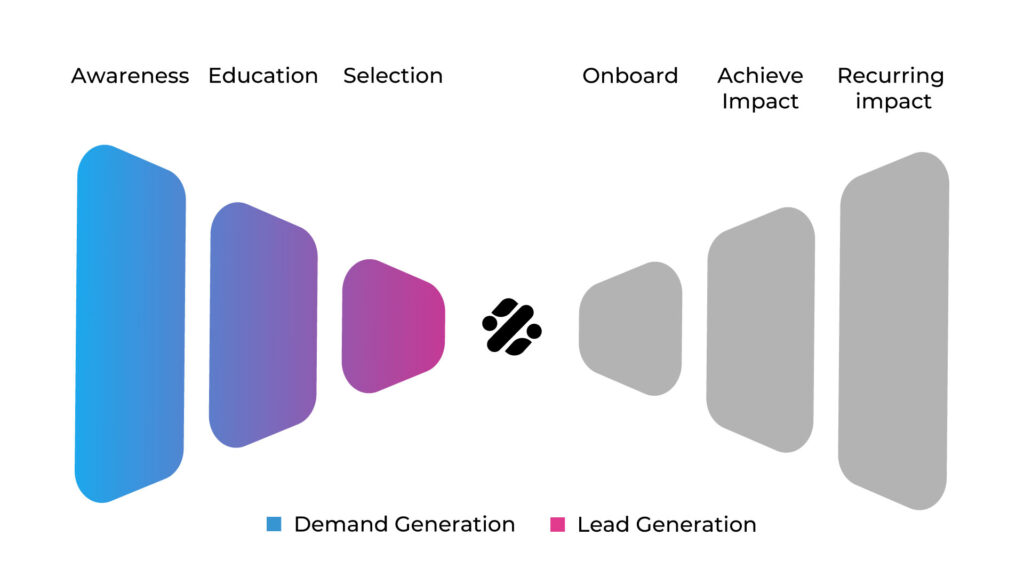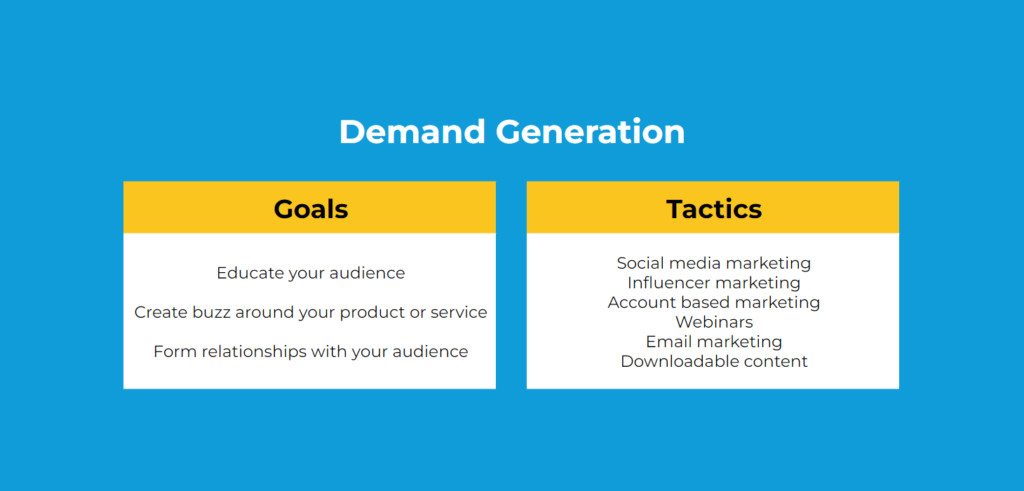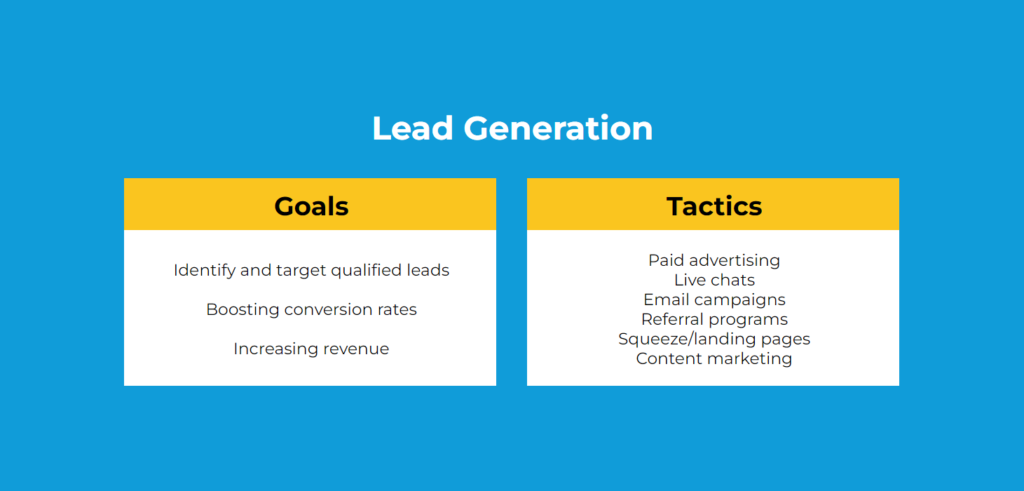Most businesses struggle to decide which route to go: demand generation or lead generation. But I think they are starting with the wrong question. A better focus point would be ‘How can my businesses drive demand AND capture the leads’?
If you attract people to your business without having the ability to convert them into paying customers, you are wasting your resources. If you perfect your conversion process but don’t have anyone to convert, you are missing out on potential revenue.
Demand gen vs lead gen
Getting the consumers’ attention is difficult. And when you manage to get their attention, getting your message through and convincing them you have the right solution is a tough challenge.
However, things get simpler when you split the problem into demand generation and lead generation.
With demand generation, you create awareness and interest in your company’s products or services. This allows you to educate your audience, make them aware of a problem they might have, and increase your brand’s authority in the space.
Lead generation is when you turn all of those efforts of attracting the consumer’s attention into hot leads. This is where your audience has decided to choose your business over others and makes the transaction.

Demand Generation
The main purpose of demand gen campaigns is to increase brand awareness, educate audiences, and generate trust.
You do this by making your audiences aware of your business and getting them interested in your products or services.
But this is not as simple as pumping out content that focuses on your target audience. You need to have a clear strategy and start by setting clear goals and taking steps to achieve them.

With demand generation, you are playing the long game which has a compounding effect on all your marketing efforts.
Think of your experience with the brands that targeted you. How did they communicate their message when they were trying to make you aware of their existence? They didn’t try to sell you anything. They were getting you hyped about the next big thing, explaining the benefits or just trying to stay top of mind.
So when you’re in the market for their product category they will have a better chance of convincing you to buy their product or service. That’s because they have created a sense of familiarity with their brand.
To measure the success of your demand generation efforts, you can keep an eye on these metrics:
- Website traffic
- Social engagement
- Brand sentiment
- Content performance
- Percentage of new users reached
- Event registrations and attendees
Lead generation
Lead generation is all about nurturing and converting people into customers. You need to convince your audience that what you offer will help them meet their needs.
Often, this involves getting a prospect’s contact information and name when they show interest in your offer. This will move them further in the customer journey and prepare them for a call with a sales rep.

Compared to demand generation, lead generation is a more short-term marketing strategy. Because they are already familiar with your brand, you only have to tell them what’s in it for them.
And here is where you double down on remarketing. You can repeat the previous message along with new bits of information to the same people who have already visited your website.
To check whether your efforts are yielding results, you can look at these metrics:
- Ad copy performance (click-through rate, ad quality, etc.)
- Conversion rate
- Conversion lag/delay
- The ratio of Marketing Qualified Lead (MQL) to Sales Qualified Lead (SQL)
- Total lead value
- Customer acquisition cost (CAC)
- Customer lifetime value
How do demand generation and lead generation come together?
Demand gen and lead gen are just 2 sides of the same coin. They are just different parts of the customer journey. Gartner has put together a nice comparative analysis of the two.

But even though they seem disconnected, they do influence each other.
First, you want to cast a wide net with your demand gen campaigns. After that, you will want to sift through the potential leads and identify the ones that are most likely to convert.
And if the newly acquired users are happy with the service or product you provide they will share their experience with other potential users. This will, in turn, help with the demand generation efforts.
However, you need to align your tactics and messaging to have a cohesive overall marketing strategy. For this, you can make use of some of the 6 principles of persuasion formulated by Robert Cialdini: reciprocity, consistency, social proof, authority, liking, and scarcity.
Most companies use them effectively and see increased results from their marketing efforts. However, don’t overdo it. You don’t need to use all of them in your strategy. Use only the ones that match your brand vision.
For example, if you want to boost your sales, don’t use discounts or limited-time offers to create scarcity. This will devalue your brand and if you do this on a regular basis, people will wait for the next discount to purchase. And overall, you risk reducing the overall revenue.
Instead, you can partner up with someone who has authority in the industry and create a limited edition product besides your regular products.
Example how demand gen and lead gen can work together
Let’s say you have a SaaS business that sits between ecommerce businesses and shipping carriers. You are negotiating with the shipping companies lower shipping prices if you buy pre-paid shipping labels in bulk. Then, you can then sell to ecommerce businesses at a small markup.
When you think about the demand generation strategy, you should start with your company’s ‘why’. You need to communicate to your audience and customers the purpose of your business: to offer small shops better chances of success in a very competitive space.
To start with your upper funnel tactics you can:
- Create social ads targeting people who are in ecommerce groups
- Partner up with course creators
- Use influencer marketing and sponsor some ecommerce content creators
- Participate in ecommerce fairs
- Use your blog as a source of ecommerce information
- Host webinars with industry experts and discuss overall trends and macro topics
- Host webinars with some of your clients and discuss particular business challenges and micro topics related to their specific case
- Organize or encourage customers to organize meet-ups to discuss ecommerce
- Share as much free information as possible with the people you are targeting
For the mid to lower funnel tactics you can:
- Retarget website visitors with social ads
- Write some sales-oriented blog articles
- Run search engine ads to capture the demand you have previously generated
- Optimize your landing pages by focusing on improving conversion rates
- Have lead magnets in place in the form of downloadable content
- Once you have their information, use email marketing to nurture the leads
But remember, you need to be consistent. Your company’s ‘why’ should be present in all of your tactics. This will get people behind your cause and become advocates for your cause. And when you put this in the customer journey, you will see that these tactics work as one big engine.
When it comes to tracking, it is important to know that you will not be able to pinpoint the effectiveness of each tactic. The best way of measuring your results is by looking at the marketing efficiency ratio.
Also, it is important to discuss with your customers how they have heard about your business and how they understood your message. This can help identify the stronger tactics and give you improvement ideas.



